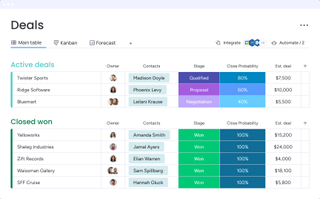Best collaboration platform for teams of 2024
The need for workplace collaboration is direr than ever
The need for workplace collaboration is direr than ever, especially as many companies have embraced remote work for employees. Despite working in different regions and time zones, employees must collaborate with each other to further the goals of their organization.

1. Best overall
2. Best for communications
3. Best for project management
4. Best for large teams
5. Best alternative to Microsoft 365
6. FAQs
7. How we test
The good thing is that workplace collaboration is now easy, thanks to the unprecedented rise of various online collaboration tools. These tools make it easy for employees to connect and share documents, office notes, memos, etc.
We scoured the web to select the best online collaboration platforms for workplace teams. We identified them after considering important factors including pricing, ease of use, features, customer support, etc.
Also check out the best free project management software.
Reader Offer: Save 18% on Monday.com annual membership
Monday.com is an easy-to-use and customizable work management platform, enabling teams of all sizes to plan, manage and centralize work. Get started now and boost your team's communication and productivity.
Preferred partner (What does this mean?)
We've also listed the best productivity tools.
The best collaboration platforms for teams of 2024 in full:
Why you can trust TechRadar
Best overall

Reasons to buy
Reasons to avoid
Slack may need no introduction because it is the most popular workplace collaboration platform out there. It was an independent platform until getting acquired by Salesforce in 2021. Under Salesforce, Slack has continued to thrive in its area of focus with minor changes.
Slack is known for having a very intuitive and visually-appealing interface. The platform sports a modern design and look that makes it enjoyable to use. You can download the Slack app on your desktop or mobile device or access it via the web.
Once you sign into Slack and join a corporate network, you can start instantly communicating with other members of the network. You can also join group chats where multiple people can converse simultaneously. Likewise, this app supports voice and video calls, so you can hold in-depth discussions with colleagues just as you’d do in person.
Slack is very easy and straightforward to use. The main drawback is that it’s a pricey tool compared to the competition.
Read our full Slack review.
Best for communications

Reasons to buy
Reasons to avoid
Microsoft is a famous software vendor that almost everyone knows. In 2017, the company released Teams, a business communication platform. Teams has been the primary competitor to Slack ever since its release and offers similar features plus its own advantages.
One of the best things about Microsoft Teams is that it offers audio-conferencing and video-conferencing tools. These tools enable you to communicate instantly with other employees, and communication is seamless and has little lag. It’s a much better tool for audio and video conferencing than Slack, likely because Microsoft already had a lot of expertise in developing such tools before releasing its Teams software (Slack, on the other hand, had to build that expertise from scratch).
Another advantage of Teams is that it’s free for companies that already subscribe to the Microsoft 365 software suite. This is the tactic that Microsoft employed to attract customers, even to the chagrin of competitors like Slack and Zoom.
Teams is the best business collaboration platform for companies already familiar with the Microsoft system and want to remain in it. But, it has some noticeable disadvantages such as a confusing interface and buggy notifications about app activities.
Read our full Microsoft Teams review.
Best for project management

Reasons to buy
Reasons to avoid
Monday.com (formerly dapulse) is another popular cloud-based online collaboration platform. It’s famous for its flexibility; the platform offers features tailored for different types of teams, e.g., marketing, sales, product development, HR, etc. It also allows extensive customization, so customers can add more features that they need.
Monday.com makes it easy for multiple employees to manage a project. The lead manager can set goals and everyone can indicate their progress for others to track in real time. The leader can assign tasks to different users, and they’ll each indicate when they have completed theirs. It gives everyone a clear picture of what they’re supposed to do and who is contributing or not to the project.
This platform has numerous third-party integrations to add extra features. For example, you can integrate it with Dropbox to share and preview files securely, Zoom for video-conferencing, and even Slack to share information in Slack channels directly from Monday.com.
The main drawbacks of using Monday.com is that it’s expensive relative to the competition and pretty complex to use. It can be confusing for non-technical users, but they’ll likely get used to the platform with time.
Read our full Monday.com review.
Best for large teams

Reasons to buy
Reasons to avoid
Wrike is a platform that makes it easy for large teams to manage and collaborate on projects. Within a team, the leader(s) can set priorities for a project and assign distinct tasks to different users. Then, everyone works on their assigned task to complete the broader project. Everyone working on the project will have ample visibility into who is supposed to perform what and if they are progressing on their assigned task.
Wrike provides project management dashboards to give managers a detailed overview of their project and their team's progress in real-time. This dashboard delivers all the important metrics in real time, e.g., revenue, deals won, revenue at risk, etc. Users can also create custom reports to present to other stakeholders on the progress of the project.
On its own, Wrike doesn’t have real-time chat or video and audio conferencing. But, third-party integrations provide extra features. For instance, you can link it to your Slack account to enable instant communication within the workplace. You can link it with Intercom for video and voice communication, QuickBooks for accounting, Dropbox and Box for file storage and management, etc.
Wrike is relatively expensive for small teams but the cost becomes cheaper for large teams due to bulk discounts.
Read our full Wrike review.
Best alternative to Microsoft 365

Reasons to buy
Reasons to avoid
Google is best known for offering a search engine and other popular products such as Gmail, Google Drive, and Google Docs. The company offers a business collaboration software suite called Workspace that bundles many of its popular services for business users.
With a single Google Workspace subscription, businesses can access many useful tools including Gmail, Docs, Drive, Meet, Chat, Slides, and Calendar.
Google’s corporate Gmail service works just like the one most consumers are used to, but you can use your own custom domain name for it. With Drive, you can store and share files easily across your organization. Google Docs enables you to type and save word documents or spreadsheets with ease.
Google Meet is an audio and video conferencing solution offered by Google. You can launch secure video and audio meetings with colleagues by sharing a simple link with them. This is notably one of the easiest audio/video conferencing solutions to use.
The main advantage of Google Workspace is that it gives your business access to a host of collaboration tools that employees may already be familiar with from their regular usage. Thus, it’s one of the easiest collaboration platforms to use.
Read our full Google Workspace review.
Best collaboration platform for teams FAQs
Factors to consider when choosing a business collaboration platform
Cost: Pricing can vary a lot for different business collaboration tools. Some may be expensive for small teams but cheaper for large teams or vice versa. Some are just more expensive than others regardless of team size. It’s important to choose a platform that fits into your budget or you risk being locked out from your collaboration platform due to lack of payment.
Ease of use: The platform you select should have an intuitive interface that makes it easy to use. Not all employees are technical and can work their way through complex user interfaces, so choosing one that’s easy for both the layman and technical expert to use is paramount.
Integrations: Your chosen business collaboration platform will likely not give you all the features you need, so there’s a need for third-party integration to provide extra features. You should pick a platform with support for many third-party integrations so that you can access a broad feature set.
Customer support: Things can go wrong at any time, and you’ll need customer support to rectify some issues. Thus, you should consider the customer service reputation of the platform you’re choosing. Check user reviews to see if the platform has a good reputation and avoid those with excessive complaints about customer service.
Device compatibility: It is preferable to choose a platform with apps for both iOS and Android and desktop operating systems including macOS, Windows, and Linux, and is also accessible via the web. This makes it easy for anyone within your organization to connect regardless of what type of device or operating system they’re using.
How we tested the best collaboration platform for teams
To test for the best collaboration platform for teams we searched for a range of popular options as well as took recommendations from people we know who use collaboration tools regularly. We then tried each platform to see how user-friendly each was, as well as determine what range of tools and advanced options were available. Pricing also came into account when determining our best list.
Read how we test, rate, and review products on TechRadar.
We've also listed the best Microsoft Teams apps.
Get in touch
- Want to find out about commercial or marketing opportunities? Click here
- Out of date info, errors, complaints or broken links? Give us a nudge
- Got a suggestion for a product or service provider? Message us directly
- You've reached the end of the page. Jump back up to the top ^
Are you a pro? Subscribe to our newsletter
Sign up to the TechRadar Pro newsletter to get all the top news, opinion, features and guidance your business needs to succeed!
Stefan has always been a lover of tech. He graduated with an MSc in geological engineering but soon discovered he had a knack for writing instead. So he decided to combine his newfound and life-long passions to become a technology writer. As a freelance content writer, Stefan can break down complex technological topics, making them easily digestible for the lay audience.


